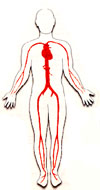|
ANTI-AGING THERAPIES is your guide to drugs and
nutrients which have been proposed as therapies to slow and/or reverse
human aging. Short reviews of these therapies are included in this
section, which links to articles, product descriptions and ordering
information.
The only method proven to slow aging and extend lifespan in mammals is
caloric restriction of a nutrient-rich diet, which has been demonstrated
to work in rats, mice, and is now being studied in monkeys. While some
people practice caloric restriction as a means of extending lifespan, its
primary value is as a model to explore how aging can be controlled.
Although none of the therapies in this section have been proven to retard
aging, there is suggestive scientific evidence that they may have this
ability. The Life Extension Foundation has launched two major, long-term
research programs -- The Lifespan Project and The Rejuvenation Project --
aimed at developing evidence to determine if supplemental drugs and
nutrients can slow aging and extend lifespan.
ANTI-AGING Therapies Table of Contents
Deprenyl
 Deprenyl
is another chemical name for Selegiline hydrochloride. It is available in
the U.S. under the name Eldepryl. It is also available by mail from
offshore companies. In a number of clinical trials, deprenyl has improved
the condition of both Parkinson's and Alzheimer's disease. In controlled
studies, however, its long-term use for Parkinson's disease was called
into question. Evidence that deprenyl may slow aging includes studies
showing it protects brain neurons from neurotoxins (in tissue culture),
elevates levels of antioxidant enzymes, reduces levels of the
dopamine-degrading enzyme monoamine oxidase-B, and extends the lifespan of
both mice and rats. Deprenyl
is another chemical name for Selegiline hydrochloride. It is available in
the U.S. under the name Eldepryl. It is also available by mail from
offshore companies. In a number of clinical trials, deprenyl has improved
the condition of both Parkinson's and Alzheimer's disease. In controlled
studies, however, its long-term use for Parkinson's disease was called
into question. Evidence that deprenyl may slow aging includes studies
showing it protects brain neurons from neurotoxins (in tissue culture),
elevates levels of antioxidant enzymes, reduces levels of the
dopamine-degrading enzyme monoamine oxidase-B, and extends the lifespan of
both mice and rats.
Human Growth Hormone
 Human
growth hormone helps maintain the immune system and builds youthful muscle
power and strength. Growth hormone levels decline progressively with
advancing age. Scientists have demonstrated that restoring youthful levels
of growth hormone via regular injections can rejuvenate aging men and
women. A provocative study at North Dakota State showed significantly
greater survival than controls among elderly mice receiving growth hormone
injections. This study was not carried through to completion because the
researchers ran out of growth hormone. To help assess the anti-aging
potential of growth hormone, the Life Extension Foundation, as part of its
Rejuvenation Project, will soon be funding a lifespan study of the effects
of growth hormone on aging mice at the University of California at
Riverside. Another method of boosting growth hormone levels is to take
growth-hormone-stimulating nutrients such as arginine and ornithine. Several
pharmaceutical companies are developing oral secretogogues, which
stimulate growth-hormone-releasing-hormone,
the pituitary factor that induces growth hormone release. Human
growth hormone helps maintain the immune system and builds youthful muscle
power and strength. Growth hormone levels decline progressively with
advancing age. Scientists have demonstrated that restoring youthful levels
of growth hormone via regular injections can rejuvenate aging men and
women. A provocative study at North Dakota State showed significantly
greater survival than controls among elderly mice receiving growth hormone
injections. This study was not carried through to completion because the
researchers ran out of growth hormone. To help assess the anti-aging
potential of growth hormone, the Life Extension Foundation, as part of its
Rejuvenation Project, will soon be funding a lifespan study of the effects
of growth hormone on aging mice at the University of California at
Riverside. Another method of boosting growth hormone levels is to take
growth-hormone-stimulating nutrients such as arginine and ornithine. Several
pharmaceutical companies are developing oral secretogogues, which
stimulate growth-hormone-releasing-hormone,
the pituitary factor that induces growth hormone release.
DHEA
 DHEA
(dehydroepiandrosterone) is an adrenal hormone that is the precursor for
steroid hormones such as testosterone and estrogen. DHEA declines
precipitously with advancing age in both men and women. There have been
many studies showing that oral DHEA can improve neurological function,
immune function, stress disorders, and that it can be protective against
some types of cancer and cardiovascular disease. In one clinical study at
the DHEA
(dehydroepiandrosterone) is an adrenal hormone that is the precursor for
steroid hormones such as testosterone and estrogen. DHEA declines
precipitously with advancing age in both men and women. There have been
many studies showing that oral DHEA can improve neurological function,
immune function, stress disorders, and that it can be protective against
some types of cancer and cardiovascular disease. In one clinical study at
the
University of California at San Diego, 50 mgs a day of DHEA taken
daily over a 6-month period increased lean body mass and muscle strength
and the perceived physical and psychological well-being of both men and
women. One lifespan study with DHEA has been conducted in mice at a major
university. Verbal reports indicate that DHEA was not successful in
extending lifespan, but the results of that study have not yet been
reported.
Melatonin
 Melatonin is a
hormone produced by the pineal gland, which is located beneath the brain.
Melatonin is a highly potent antioxidant, which has been described as the
pacemaker of the aging clock in humans. It is released every night as part
of our time-dependent biorhythms to help induce sleep and recuperation
from fatigue. Melatonin has been shown to have anti-cancer effects. In
animal studies in Italy, melatonin and transplants of pineal gland tissue
from young animals extended the lifespan of old animals, however the mice
used in these studies had suboptimal lifespans. The Life Extension
Foundation is funding a study to further assess the effects of melatonin
on aging and lifespan in mice. Melatonin is a
hormone produced by the pineal gland, which is located beneath the brain.
Melatonin is a highly potent antioxidant, which has been described as the
pacemaker of the aging clock in humans. It is released every night as part
of our time-dependent biorhythms to help induce sleep and recuperation
from fatigue. Melatonin has been shown to have anti-cancer effects. In
animal studies in Italy, melatonin and transplants of pineal gland tissue
from young animals extended the lifespan of old animals, however the mice
used in these studies had suboptimal lifespans. The Life Extension
Foundation is funding a study to further assess the effects of melatonin
on aging and lifespan in mice.
Acetyl-L-Carnitine
 Acetyl-L-Carnitine (ALC) is
an energy-stimulating compound similar to an amino acid. It has been shown
to improve cognitive function in both normally aging individuals and
Alzheimer's patients, and to strengthen the heart muscle. The basis for
theorizing that ALC may be able to slow aging comes from evidence that ALC
improves mitochondrial function in several ways. Mitochondria are the
power plants of the cells, where energy for all life processes is
generated. Scientists have speculated that the decline in mitochondrial
function may be a cause of aging in humans. The effects of ALC on aging
and lifespan are being tested as part of The Lifespan Project. Acetyl-L-Carnitine (ALC) is
an energy-stimulating compound similar to an amino acid. It has been shown
to improve cognitive function in both normally aging individuals and
Alzheimer's patients, and to strengthen the heart muscle. The basis for
theorizing that ALC may be able to slow aging comes from evidence that ALC
improves mitochondrial function in several ways. Mitochondria are the
power plants of the cells, where energy for all life processes is
generated. Scientists have speculated that the decline in mitochondrial
function may be a cause of aging in humans. The effects of ALC on aging
and lifespan are being tested as part of The Lifespan Project.
Coenzyme Q10
 Coenzyme Q10 (CoQ10)
is a cardioprotective, energy stimulating compound that has been shown to
be effective as a means of preventing and treating certain forms of
cardiovascular disease and cancer. In a study by Bliznakov, the lifespan
of mice was increased by 50% by injections of CoQ10. In another study at
UCLA Medical Center, the mean but not maximum lifespan of mice was
increased by very high oral doses of CoQ10. In both studies, mice
receiving CoQ10 looked especially good and healthy at advanced ages. CoQ10
is being assessed further for its effects on aging and lifespan in mice as
part of The Lifespan Project. Coenzyme Q10 (CoQ10)
is a cardioprotective, energy stimulating compound that has been shown to
be effective as a means of preventing and treating certain forms of
cardiovascular disease and cancer. In a study by Bliznakov, the lifespan
of mice was increased by 50% by injections of CoQ10. In another study at
UCLA Medical Center, the mean but not maximum lifespan of mice was
increased by very high oral doses of CoQ10. In both studies, mice
receiving CoQ10 looked especially good and healthy at advanced ages. CoQ10
is being assessed further for its effects on aging and lifespan in mice as
part of The Lifespan Project.
Alpha Lipoic Acid
Alpha Lipoic Acid,
also known as Lipoic Acid, is a highly potent antioxidant that counteracts
reactive free radicals in the mitochondria, the power plants of cells
where energy for all cellular activities is generated. Some scientists
believe that mitochondrial free radicals play an important role in human
aging, and have theorized that extra amounts of free-radical inhibiting
compounds such as Alpha Lipoic Acid may be able to slow aging. Alpha
Lipoic Acid is also effective in recycling other antioxidants such as
Vitamin E back into their original form after they detoxify free radicals.
There also is evidence that Alpha Lipoic Acid can reduce glycation damage
due to excess glucose in the blood, which may be involved in aging, and
that it can improve patients with diabetes, which has been described as an
accelerated form of aging. The effects of Alpha Lipoic Acid on aging and
lifespan in mice are currently being studied in The Lifespan Project.
Cysteine and Procysteine
Cysteine is a
nonessential sulfur amino acid used for protein synthesis. An early study
in Romania showed that Cysteine could extend the lifespan of laboratory
animals, but there has been no follow-up to this study. Procysteine is a
modified form of Cysteine that is believed to be safer and more potent
than Cysteine. Both Cysteine and Procysteine play a role in the synthesis
of glutathione, a potent antioxidant found in every cell of the body,
which is involved in folding proteins into their correct structure, and
which declines in concentration with advancing age. The effects of
Procysteine on aging and lifespan in animals is being studied in The
Lifespan Project.
NADH
 NADH is a
form of nicotinamide adenine dinucleotide, a coenzyme that assists enzymes
involved in energy production within mitochondria, the power plants of the
cell. NADH plays an important role in the generation of ATP (adenosine
triphosphate), the body's energy currency, and has been found to be
effective in Europe in treating Parkinson's and Alzheimer's disease. NADH
is also needed for the regeneration of glutathione after it has become
oxidized. The Life Extension Foundation has funded a study to examine the
effects of NADH on aging and lifespan in mice. NADH is a
form of nicotinamide adenine dinucleotide, a coenzyme that assists enzymes
involved in energy production within mitochondria, the power plants of the
cell. NADH plays an important role in the generation of ATP (adenosine
triphosphate), the body's energy currency, and has been found to be
effective in Europe in treating Parkinson's and Alzheimer's disease. NADH
is also needed for the regeneration of glutathione after it has become
oxidized. The Life Extension Foundation has funded a study to examine the
effects of NADH on aging and lifespan in mice.
Lycopene
 Lycopene is a member
(along with beta-carotene) of a family of plant pigments called
carotenoids. There are more than 600 different carotenoids, but lycopene
and the carotenes are the most important ones. They are the pigments that
give leaves, tomatoes and other plants their bright colors. Lycopene is
the best anti-aging candidate of this class of compounds because it is the
most efficient quencher of an especially dangerous free radical called
singlet oxygen. Equally important is the fact that lycopene is regenerated
after quenching singlet oxygen, and can then detoxify dangerous molecules
without being destroyed. Lycopene levels drop off with age, even if we
continue eating the fruits and vegetables that contain it. Lycopene has
been shown to increase the survival of irradiated mice, and to decrease
the incidence of various types of cancer in mice. It is now the subject of
study in The Foundation's Lifespan Project. Lycopene is a member
(along with beta-carotene) of a family of plant pigments called
carotenoids. There are more than 600 different carotenoids, but lycopene
and the carotenes are the most important ones. They are the pigments that
give leaves, tomatoes and other plants their bright colors. Lycopene is
the best anti-aging candidate of this class of compounds because it is the
most efficient quencher of an especially dangerous free radical called
singlet oxygen. Equally important is the fact that lycopene is regenerated
after quenching singlet oxygen, and can then detoxify dangerous molecules
without being destroyed. Lycopene levels drop off with age, even if we
continue eating the fruits and vegetables that contain it. Lycopene has
been shown to increase the survival of irradiated mice, and to decrease
the incidence of various types of cancer in mice. It is now the subject of
study in The Foundation's Lifespan Project.
Vitamin E
 Vitamin E is
the major fat-soluble compound that protects our cell membranes against
oxidative damage. It can break the self-perpetuating chain of oxidative
reactions in unsaturated fatty acids in membranes. Vitamin E also helps
maintain the antioxidant activity of Selenium, and works with this trace
mineral to help boost immune function. There have been highly persuasive
studies in humans showing that regular Vitamin E intake can reduce the
risk of heart attacks in both men and women, and that it can protect us
from several types of cancer. In one study, the combination of Vitamin E
and Vitamin C reduced death from all causes. Vitamin E is being studied
for its effects on aging and lifespan as part of The Lifespan Project. Vitamin E is
the major fat-soluble compound that protects our cell membranes against
oxidative damage. It can break the self-perpetuating chain of oxidative
reactions in unsaturated fatty acids in membranes. Vitamin E also helps
maintain the antioxidant activity of Selenium, and works with this trace
mineral to help boost immune function. There have been highly persuasive
studies in humans showing that regular Vitamin E intake can reduce the
risk of heart attacks in both men and women, and that it can protect us
from several types of cancer. In one study, the combination of Vitamin E
and Vitamin C reduced death from all causes. Vitamin E is being studied
for its effects on aging and lifespan as part of The Lifespan Project.
Vitamin B5 (Pantothenic
Acid)
 In 1958,
biochemists Roger J. Williams and Richard Pelton fed large amounts of Vitamin B5 to male and
female mice. They found that the treated mice lived an average of 19%
longer than controls. A previous study had found that B5 increased the
lifespan of fruit flies. The major biochemical role of Vitamin B5 appears
to be as a constituent of Coenzyme A, which is involved in many chemical
reactions essential to life, including the detoxification of many
dangerous substances. When high doses of Vitamin B5 were given to rats
they were able to survive in cold water twice as long as controls. Similar
results have been found in humans. In 1958,
biochemists Roger J. Williams and Richard Pelton fed large amounts of Vitamin B5 to male and
female mice. They found that the treated mice lived an average of 19%
longer than controls. A previous study had found that B5 increased the
lifespan of fruit flies. The major biochemical role of Vitamin B5 appears
to be as a constituent of Coenzyme A, which is involved in many chemical
reactions essential to life, including the detoxification of many
dangerous substances. When high doses of Vitamin B5 were given to rats
they were able to survive in cold water twice as long as controls. Similar
results have been found in humans.
Vitamin B6
(Pyridoxine)
 In an
experiment conducted at NASA's Ames Research Center in a long-lived strain
of mice already in middle-age (18 months of age), the scientists found an
11% increase in lifespan in animals fed Vitamin B6 compared to
controls. Vitamin B6 plays an important role in many life processes. It is
needed for the metabolism of amino acids such as tyrosine and
phenylalanine, and is an essential co-factor (along with Vitamin B6 and
folic acid) in the body's defense against elevated homocysteine levels,
which have been linked to arteriosclerosis, heart disease and stroke. In an
experiment conducted at NASA's Ames Research Center in a long-lived strain
of mice already in middle-age (18 months of age), the scientists found an
11% increase in lifespan in animals fed Vitamin B6 compared to
controls. Vitamin B6 plays an important role in many life processes. It is
needed for the metabolism of amino acids such as tyrosine and
phenylalanine, and is an essential co-factor (along with Vitamin B6 and
folic acid) in the body's defense against elevated homocysteine levels,
which have been linked to arteriosclerosis, heart disease and stroke.
Synthetic
Antioxidants
 In the 1950s and 60s, Denham Harman of the University of
Nebraska Medical Center, the originator of the free radical theory of
aging, conducted a series of experiments in which he extended the lifespan
of short-lived mice with various synthetic antioxidants. The antioxidants
included BHT (butylated hydroxytoluene), Ethoxyquin
(dihydroethoxytrimethylquinolone), 2-mercapto-ethylamine (2-MEA), and
NDHGA (nordihydroguaretic Acid). Dr. Harman found mean lifespan increases
of up to 61% with these compounds. Subsequent studies confirmed the
lifespan-extending ability of Ethoxyquin and NDHGA. These supplements have
never become popular because of concern about adverse effects from their
chronic use. In the 1950s and 60s, Denham Harman of the University of
Nebraska Medical Center, the originator of the free radical theory of
aging, conducted a series of experiments in which he extended the lifespan
of short-lived mice with various synthetic antioxidants. The antioxidants
included BHT (butylated hydroxytoluene), Ethoxyquin
(dihydroethoxytrimethylquinolone), 2-mercapto-ethylamine (2-MEA), and
NDHGA (nordihydroguaretic Acid). Dr. Harman found mean lifespan increases
of up to 61% with these compounds. Subsequent studies confirmed the
lifespan-extending ability of Ethoxyquin and NDHGA. These supplements have
never become popular because of concern about adverse effects from their
chronic use.
Levodopa (L-Dopa)
 In 1977,
George Cotzias, et al. reported a 50% increase in the mean lifespan of
rats fed very high doses of L-Dopa, the precursor to the neurotransmitter
dopamine. In another study in rats, it was shown that the incidence of
movement disorders among aged rats were almost totally reversed by L-Dopa,
which enabled the rats to swim almost as well as young rats. L-Dopa is
used to treat Parkinson's disease patients, with major improvements
usually occurring for several years followed by a steep decline in
function coupled with adverse side effects. The problem with L-Dopa as an
anti-aging drug is its side effects at high doses, which include abnormal
heart rhythms, movement disorders, mental disturbances, and a greater risk
of at least one type of cancer. In 1977,
George Cotzias, et al. reported a 50% increase in the mean lifespan of
rats fed very high doses of L-Dopa, the precursor to the neurotransmitter
dopamine. In another study in rats, it was shown that the incidence of
movement disorders among aged rats were almost totally reversed by L-Dopa,
which enabled the rats to swim almost as well as young rats. L-Dopa is
used to treat Parkinson's disease patients, with major improvements
usually occurring for several years followed by a steep decline in
function coupled with adverse side effects. The problem with L-Dopa as an
anti-aging drug is its side effects at high doses, which include abnormal
heart rhythms, movement disorders, mental disturbances, and a greater risk
of at least one type of cancer.
All Contents Copyright © 1995-1999 By The Life Extension
Foundation |












